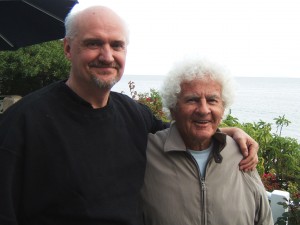by Bruce Wilson
While reading through several newspaper obituaries on Arthur Janov, one name kept coming up over and over: John C. Norcross, professor of psychology at the University of Scranton in Pennsylvania. According to Norcross, primal therapy is little more than a trendy psychotherapy that arose in the fevered sixties, and Janov was “a classic instance of being the right charismatic therapist at the right time.” And to further demonstrate his ignorance, Dr. Norcross says in the New York Times, “There is no evidence that screaming and catharsis bring long-term emotional relief.”
This comment is repeated again and again in obit after obit, merely parroting the NYT review. But the review also states:
Much of the psychotherapeutic establishment now regards the therapy as marginal. A 2006 article by Dr. Norcross and colleagues in the journal Professional Psychology: Research and Practice reported that their survey of more than 100 “leading mental health professionals” had found primal therapy to be “certainly discredited” — together with treatments including angel therapy, crystal healing, past-lives therapy, future-lives therapy and post-alien-abduction therapy.
“It’s both a discredited theory and treatment in mental health,” Dr. Norcross said. “Today, I look back at it as an unfortunate but understandable product of its time: believing that pure emotional release would prove therapeutic.”
Those are pretty strong words. After all, if you deem something to be “discredited” you should have extensive evidence to back it up, right?
Wrong.
This survey enrolled 101 so-called mental health experts to assess 59 treatments by questionnaire. “Experts” were decided by criteria such as doctorate-level education, fellows of the American Psychological Association (APA) or American Psychological Society (APS), current and former editors of scholarly journals in mental health, members of the APA Presidential Task Force on Evidence-Based Practice, and chairs or editors of the Diagnostic and Statistical Manual of Mental Disorders (DSM). In other words, no one who had ever practiced primal therapy was included. Overall, 66% of respondents were supporters of cognitive behavioral therapy (CBT) or “eclectic/integrative” therapy. In other words, these “experts” represented the dominant wing of the psychological establishment, which has always been critical of primal therapy and the notion of repressed memory.
The term “discredited” was based on the following criteria:
We operationally define discredited as those unable to consistently generate treatment outcomes (treatments)…beyond that obtained by the passage of time alone, expectancy, base rates, or credible placebo. Discredited subsumes ineffective and detrimental interventions but forms a broader and more inclusive characterization. We are interested in identifying disproven practices.
The criteria for making the discredited ratings were left to the respondents on the basis of “several types of evidence: peer-reviewed controlled research, clinical practice, and/or professional consensus.”
On a scale where 1 =not at all discredited, 2=unlikely discredited, 3=possibly discredited, 4=probably discredited, and 5=certainly discredited, “primal scream therapy” was rated as 4.51, i.e. “probably discredited” and halfway to “certainly discredited.” Primal was regarded as less credible than “standard prefrontal lobotomy for treatment of mental/behavioral disorders (4.44),” “Erhard Seminar Training for treatment of mental/behavioral disorders (4.29),” and “Psychotherapy for the treatment of penis envy (3.60).”
Therapies deemed as “unlikely discredited” included “eye movement and desensization processing (EMDR) (2.88)”, “laughter or humor therapy for treatment of depression (2.83)” (I kid you not!), “psychosocial (nonbehavioral) therapies for ADHD (2.85),” and thought-stopping procedures for ruminations/intrusive worry (2.25).” The only therapy regarded as not at all discredited, by a narrow margin, was “behavior therapy for sex offenders (1.97).”
Echoing the NYT obit, the authors concluded, “experts considered as certainly discredited 14 psychological treatments: angel therapy, use of pyramid structures, orgone therapy, crystal healing, past lives therapy, future lives therapy, treatments for post-traumatic stress disorder (PTSD) caused by alien abduction, rebirthing therapies, color therapy, primal scream, chiropractic manipulation, thought field therapy, standard prefrontal lobotomy, and aroma therapy.”
Stunning ignorance, I know. But take a deep breath.
In all the therapies listed, except the cognitively based therapies, cognitive behavioral therapists were more likely to rate them as discredited. Not only that, but most of these “experts” were not even familiar with many of the treatments. And yet they felt competent to judge them. With regard to “primal scream therapy,” 6% were not familiar with the therapy. Actually, I would say zero percent were familiar with the therapy because it is not called primal scream therapy!
Nowhere is the “evidence” mentioned that substantiates these “expert’” decisions. I assume they just cherry picked whatever papers fit their therapeutic orientation, or perhaps they just gathered around their virtual water cooler and made up that “professional consensus.” As for “primal scream therapy” they had obviously done no research to find out that primal therapy has nothing to do with screaming.
So this is the sort of misinformation about primal therapy that is circulating around the psychological community and the mainstream press. Decades ago, Art Janov decided to distance himself from the mental health establishment for this very reason. Despite his many efforts to convince his colleagues that his therapy worked, he was met with ridicule and outright defamation. Since then, primal therapy has existed on its own, quietly advancing as the decades have passed, and some respected psychologists, physicians, and neuroscientists have come to appreciate its effectiveness: Louis Cozolino, Justin Feinstein, Jaak Panksepp, Paul Thompson, and Gabor Maté, to name a few. And although the therapy still needs to be researched, it will be done without the participation of these “expert” clowns.


